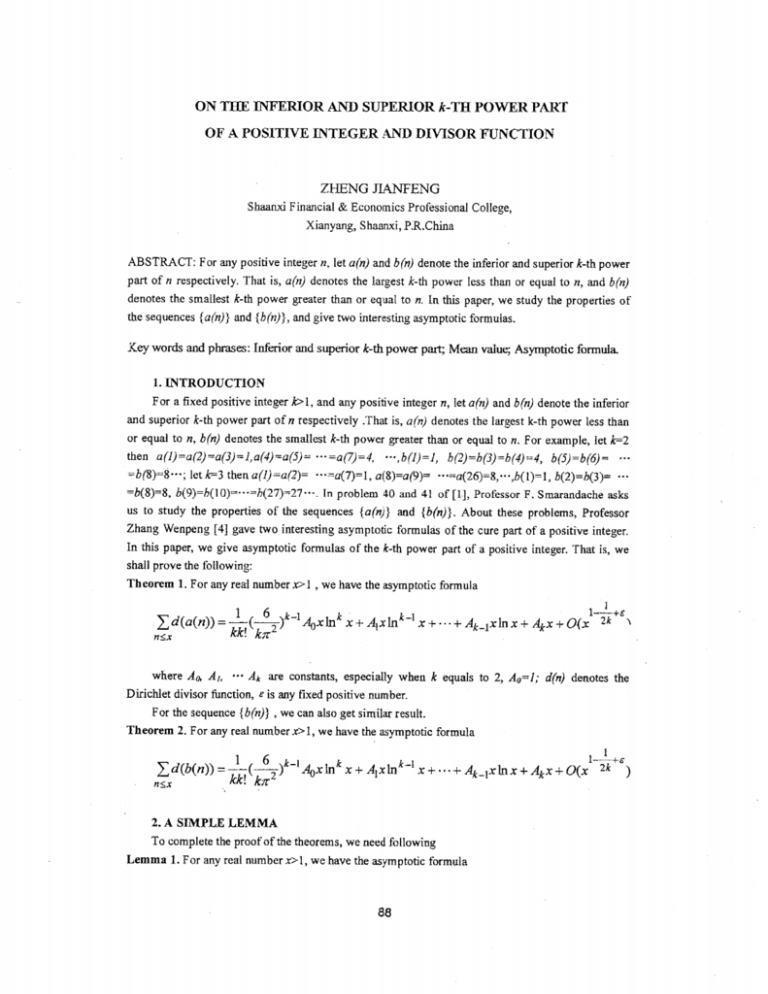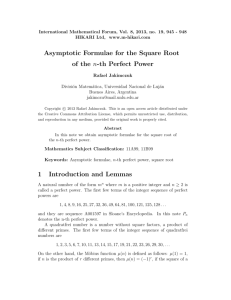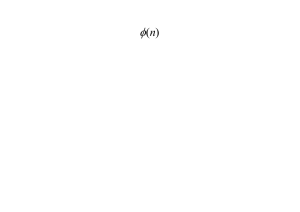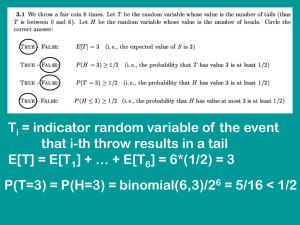ON THE INFERIOR AND SUPERIOR k-TH POWER PART
advertisement

ON THE INFERIOR AND SUPERIOR k-TH POWER PART
OF A POSITIVE INTEGER AND DIVISOR FUNCTION
ZHENG JIANFENG
Shaanxi Financial & Economics Professional College,
Xianyang, Shaanxi, P.R.China
ABSTRACT: For any positive integer n, let a{n) and b{n) denote the inferior and superior k-th power
part of n respectively. That is, a(n) denotes the largest k-th power less than or equal to n, and b(n)
denotes the smallest k-th power greater than or equal to n. In this paper, we study the properties of
the sequences {a(n)} and {b{n)}, and give two interesting asymptotic formulas.
Xey words and phrases: Inferior and superior k-th power part; Mean value; Asymptotic formula.
1. INTRODUCTION
For a fixed positive integer k>1, and any positive integer n, let a(n) and b(n) denote the inferior
and superior k-th power part of n respectively .That is, a(n) denotes the largest k-th power less than
or equal to n, b(n) denotes the smallest k-th power greater than or equal to n.For example, let k=2
then a(l)=a(2)=a(3)=l,a(4)=a(5)= "'=a(7)=4,
···,b(l)=l, b(2) =b(3) =b(4) =4, b(5)=b(6)= ...
:::;:b(8)=8"'; let k=3 then a(1)=a(2)= "'=a(7)=1, a(8)=a(9)= ···=a(26)=8,···,b(1)=1, b(2)=b(3)= •..
=b(8)=8, b(9)=b(lO)=···=b(27)=27···. In problem 40 and 41 of [1], Professor F. Smarandache asks
us to study the properties of the sequences {a(n)} and {b{n)}. About these problems, Professor
Zhang Wenpeng [4] gave two interesting asymptotic formuhis of the cure part of a positive integer.
In this paper, we give asymptotic formulas of the
k~th
power part of a positive integer. That is, we
shall prove the following:
Theorem 1. For any real number x> 1 , we have the asymptotic formula
wnere Ao. A j •
• ••
Ak are constants, especially when k equals to 2, Ao=l; d(n) denotes the
Dirichlet divisor function, e is any flxed positive number.
For the sequence {b(n)} • we can also get similar result.
Theorem 2. For any real number x> 1, we have the asymptotic formula
16k
k
Id(b(n))=-(-z) -IAoxln x+Alxln
n~x
kk! k1r
1
1--+&
k
-1
x+ ... +Ak_Ixlnx+AkX+O(x
2. A SIMPLE LEMMA
To complete the proof of the theorems, we need following
Lemma 1. For any real number x> 1, we have the asymptotic formula
88
2k
)
where Bo, B1,
•••
Ao=-l; e is any fixed positive number.
Bk are constants, especially when
d(nk)
~-s-
I
<Xl
Proof. Let s = a
+ it be a complex number and f(s)
=:
n=!
Note that
d (n K ) << nt: , So
.
n
it is clear that I(s) is a Dirichlet series absolutely convergent in
Re(s» 1, by the Euler Product formula [2] and the definition of d(n) we have
/(s)=
=:
IT ( 1+ d p
k
+ d (p 2k) + .,. + d (p kn) + ...
P 2s
p
rr(l
p
=
s
J
pM
1 1
1 J
+ k + + 2k + + ... + len + + ...
p'
pm
;2(8)1]
(1 + -1) ;,
(k
=:(2(s)n((l+~s)k-l -Cf-l
p
P
P
12s'
...
1
p(k-l)s
J
(1)
where ((s) is Riem~n zeta-function and
IT
denotes the product over all primes.
p
From (1) and Perron's formula [3] we have
(2)
where g(s) is absolutely convergent in Re(s)
> .!. + 8. We move the integration in (2) to
2
Re(s) = 1 + 8. The pole at s 1 contributes to
2
16 k 1
k
k-l
' (-2) -, Eoxln x + E1x In X + ... + Bk_1X In X + Bkx ,
k .1t
where Eo, Bl " ..
1
For
2
:::;; a
Bk
are constants, especially when k
< 1, note that t;(s) = S(a + it) :s;
~
(3)
= 2, Bo = 1.
Itl2+e .Thus, the horizontal integral contributes to
as
(4)
and the vertical integral contributes to
(5)
On the line Re(s) =
!
2
+ 8 , taking parameter T
x~ , then combining (2), (3), (4) and (5) we
have
This proves Lemma 1.
3. PROOFS OF THE THEOREMS
Now we complete the proof of the Theorems. First we prove Theorem 1.
For any real number x> 1, Let Mbe a frxed positive integer such that
(6)
then, from the defmition of a(n), we have
I
M
d(a(n)) =
n'5..x:
.L d(a(n) + .L d(a(n»)
I
m=2 (m_l)k sn<mk
Mit !,ns,x
M-I
=
I
Id(mk)+
m""l m k :S:n«m+l)k
Id(Mk)
Mit SnSx
M
= k 'Lmk-Id(mk) + O(M k- 1+j,
(7)
m=l
where we have used the estimate
Let B(y)
d(n)« nt: ..
~ Ld(nk ) , then byAbel's identity and Lemma 1, we have
nsy
M
"Lmk-Id(mk)
m=l
=Mk-tB(M) -(k -1)
r
yk-2B(y)dy+ 0(1)
=M>-t~!(:,)'-IBoMlnk M +B,Mln k- M +···+B,MJ
1
90
(8)
Applying (7) and (8) we obtain the asymptotic formula
'Ld(a(n)) =
n~x
ifk!l1C
-;)k-lBoMk Ink M + C1M k ln k- I M + ... + CIe_1M k + j Mk-i+£J,
\/l
(9)
where BO,C1,"',Ck _I are constants.
From (6) we have the estimates
1
I
=M k - 1(k+C 2 _+ ... + __ )«x
k M
M k- I
Ie-I
Ie
(10)
'
and
J x) =k'In'M+O(x
.
ln
k 1
-
tok X
k'lnkM+~l.)
Combining (9),
(l0) and (11) we have
k
(11)
).
,
16k 1
Ld(a(n))=~'(-2) n<;;x
-!..+c
kk. k1C
k
k 1
Aoxln x+AlxIn - x+
1
1--+&
.. ·+Ak_lxlnx+Akx+O(x 2k ),
where Ao equals to Bo .
This proves Theorem 1.
Using the methods of proving Theorem 1 we can also prove Theorem 2. This completes the proof of
the Theorems.
Acknowledgments
The author expresses his gratitude to professor Zhang Wenpeng for his very helps and detailed
instructions.
REFERENCES:
1. F.Smarandache, Only problems, not Solutions, Xiquan Publ. House, Chicago, 1993, PP. 35.
2. T.M.Apostol, Introduction to Analytic Number Theory,
Springer~Verlag,
New York, 1976.
3. Pan Chengdong and Pan Chengbiao, Foundation of Analytic Number Theory, Science Press, Beijing, 1997, PP. 98.
4. Zhang Wenpcng, On the cube part sequence of a positive integer (to appear).





